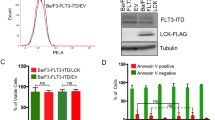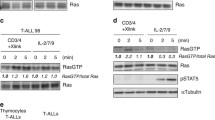Abstract
Growth factors promote cell survival and proliferation. Homeostasis is maintained by programmed cell death which occurs when the growth stimulus is withdrawn, in response to negative growth regulators such as interferons, TNF-α and CD95 ligand, or following differentiation. Although acutely-transforming oncogenes often overcome the need for growth factors, growth regulatory cytokines can influence proliferative responses of transformed cells. In this study we investigated the effects of IL-3 on the proliferative responses of parental bone marrow-derived 32D cells and cells transformed with ras and abl oncogenes. We show that treatment of ras-transformed 32D cells with IL-3 reduced proliferative responses and decreased colony-forming ability. These effects were exacerbated in the absence of serum and associated with inhibition of tyrosine kinase activity, down-regulation of RAS and MYC expression, and induction of apoptosis as indicated by DNA fragmentation. In contrast, treatment of parental 32D cells with IL-3, which is obligatory for cell survival and proliferation, increased tyrosine kinase activity, upregulated MYC and RAS expression and maintained DNA integrity. With abl-transformed cells, proliferation and colony-forming ability were also inhibited by IL-3. Tyrosine kinase activity and MYC expression were reduced, but early apoptosis was not evident. Calcium uptake however, was stimulated by IL-3 in both parental and oncogene-transformed cells. These results suggest that threshold levels of tyrosine kinase activity are necessary for cell survival and proliferation and that with ras-transformed cells, IL-3 treatment may result in this threshold being breached. We conclude that in some situations, growth-promoting cytokines can inhibit proliferation of transformed cells and induce cell death by apoptosis.
Similar content being viewed by others
References
Arends MJ, Wyllie AH. Apoptosis: Mechanisms and roles in pathology. Int Rev Exp Path 1991; 32: 223–254.
Thompson CB. Apoptosis in the pathogenesis and treatment of disease. Science 1995; 267: 1456–1462.
Salvesen GS, Dixit VM. Caspases: intracellular signaling by proteolysis. Cell 1997; 91: 443–446.
Cohen GM. Caspases: the executioners of apoptosis. Biochem J 1997; 326: 1–16.
Nagata S. Apoptosis by death factor. Cell 1997; 88: 355–365.
Cohen GM, Sun XM, Fearnhead H, et al. Formation of large molecular weight fragments of DNA is a key committed step of apoptosis in thymocytes. J Immunol 1994; 153: 507–516.
Enari M, Sakahira H, Yokoyama H, et al. A caspase-activated DNase that degrades DNA during apoptosis, and its inhibitor ICAD. Nature 1998; 391: 43–50.
Steller H. Mechanisms and genes of cellular suicide. Science 1995; 267: 1445–1449.
Gulbins E, Bissonnette R, Mahboubi A, et al. FAS-induced apoptosis is mediated via a ceramide-initiated RAS signaling pathway. Immunity 1995; 2: 341–351.
Chen CY, Liou J, Forman LW, Faller DV. Differential regulation of discrete apoptotic pathways by Ras. J Biol Chem 1998; 273: 16700–16708.
Chen CY, Faller DV. Phosphorylation of Bcl-2 protein and association with p21Ras in Ras-induced apoptosis. J Biol Chem 1996; 271: 2376–2379.
Arends MJ, McGregor AH, Toft NJ, Brown EJ, Wyllie AH. Susceptibility to apoptosis is differentially regulated by c-myc and mutated Ha-ras oncogenes and is associated with endonuclease availability. Brit J Cancer 1993; 68: 1127–1133.
Hermens AF, Bentvelzen PA. Influence of the H-ras oncogene on radiation responses of a rat rhabdomyosarcoma cell line. Cancer Res 1992; 52: 3073–3082.
Fernandez A, Marin MC, McDonnell T, Ananthaswamy HN. Differential sensitivity of normal and Ha-ras-transformed C3H mouse embryo fibroblasts to tumor necrosis factor: induction of bcl-2, c-myc, and manganese superoxide dismutase in resistant cells. Oncogene 1994; 9: 2009–2017.
Askew DS, Ashmun RA, Simmons BC, Cleveland JL. Constitutive c-myc expression in an IL-3-dependent myeloid cell line suppresses cell cycle arrest and accelerates apoptosis. Oncogene 1991; 6: 1915–1922.
Evan GI, Wyllie AH, Gilbert CS, et al. Induction of apoptosis in fibroblasts by c-myc protein. Cell 1992; 69: 119–128.
Jacobson MD, Burne JF, Raff MC. Programmed cell death and Bcl-2 protection in the absence of a nucleus. EMBO J 1994; 13: 1899–1910.
Chen YY, Rosenberg N. Lymphoid cells transformed by Abelson virus require the v-abl protein-tyrosine kinase only during early G1. Proc Natl Acad Sci USA 1992; 89: 6683–6687.
Whyte M, Evan G. Apoptosis. The last cut is the deepest. Nature 1995; 376: 17–18.
Uckun FM, Tuel AL, Song CW, et al. Ionizing radiation stimulates unidentified tyrosine-specific protein kinases in human B-lymphocyte precursors, triggering apoptosis and clonogenic cell death. Proc Natl Acad Sci USA 1992; 89: 9005–9009.
Armstrong DK, Kaufmann SH, Ottaviano YL, et al. Epidermal growth factor-mediated apoptosis of MDA-MB-468 human breast cancer cells. Cancer Res 1994; 54: 5280–5283.
Brabyn CJ, Franks DJ, Kleine LP. Long-term exposure to epidermal growth factor results in apoptosis in T51B cells. Biochem Cell Biol 1994; 72: 429–438.
Gooch JL, Lee AV, Yee D. Interleukin 4 inhibits growth and induces apoptosis in human breast cancer cells. Cancer Res 1998; 58: 4199–4205.
Greenberger JS, Sakakeeny MA, Humphries RK, Eaves CJ, Eckner RJ. Demonstration of permanent factor-dependent multipotential (erythroid/neutrophil/basophil) hematopoietic cell lines. Proc Natl Acad Sci USA 1983; 80: 2931–2935.
DeClue JE, Stone JC, Blanchard RA, et al. A ras effector domain mutant which is temperature sensitive for cellular transformation: interactions with GTPase-activating protein and NF-1. Mol Cell Biol 1991; 11: 3132–3138.
Kipreos ET, Lee GJ, Wang JY. Isolation of temperature-sensitive tyrosine kinase mutants of v-abl oncogene by screening with antibodies for phosphotyrosine. Proc Natl Sci USA 1987; 84: 1345–1349.
Cheng HC, Nishio H, Hatase O, Ralph S, Wang JH. A synthetic peptide derived from p34cdc2 is a specific and efficient substrate of src-family tyrosine kinases. J Biol Chem 1992; 267: 9248–9256.
Bradford MM. A rapid and sensitive method for the quantitation of microgram quantities of protein utilizing the principle of protein-dye binding. Anal Biochem 1976; 72: 248–254.
Watson JD, Jenkins DR, Eszes M, Leung E. Effect of granulocyte-macrophage colony-stimulating factor and interleukin 3 on the v-src oncogene. Inhibition of tyrosine kinase activity in the absence of changes in gene expression. J Immunol 1988; 140: 501–507.
Watson JD, Prestidge RL, Jenkins DR. Cytokines that inhibit tyrosine kinase activity: Receptor structure and signal transduction. In: Cacciola E, Deisseroth AB, Giustolisi R, eds. Hemopoietic growth factors, oncogenes and cytokines in clinical hematology. Basel: Karger 1994: 64–78.
McGahon A, Bissonnette R, Schmitt M, et al. BCR-ABL maintains resistance of chronic myelogenous leukemia cells to apoptotic cell death. Blood 1994; 83: 1179–1187.
McGahon AJ, Nishioka WK, Martin SJ, et al. Regulation of the Fas apoptotic cell death pathway by Abl. J Biol Chem 1995; 270: 22625–22631.
Yi TL, Cleveland JL, Ihle JN. Protein tyrosine phosphatase containing SH2 domains: characterization, preferential expression in hematopoietic cells, and localization to human chromosome 12p12-p13. Mol Cell Biol 1992; 12: 836–846.
Su X, Zhou T, Wang Z, et al. Defective expression of hematopoietic cell protein tyrosine phosphatase (HCP) in lymphoid cells blocks Fas-mediated apoptosis. Immunity 1995; 2: 353–362.
Sun H, Tonks NK, Bar SD. Inhibition of Ras-induced DNA synthesis by expression of the phosphatase MKP-1. Science 1994; 266: 285–288.
Singh S, Aggarwal BB. Protein-tyrosine phosphatase inhibitors block tumor necrosis factor-dependent activation of the nuclear transcription factor NF-kappa B. J Biol Chem 1995; 270: 10631–10639.
Dobrowsky RT, Hannun YA. Ceramide stimulates a cytosolic protein phosphatase. J Biol Chem 1992; 267: 5048–5051.
Chin YE, Kitagawa M, Su WC, et al. Cell growth arrest and induction of cyclin-dependent kinase inhibitor p21 WAF1/CIP1 mediated by STAT1. Science 1996; 272: 719–722.
Gore SD, Donnenberg AD, Zehnbauer BA, Weng LJ, Burke PJ. Granulocyte-macrophage colony-stimulating factor (GMCSF), given concurrently with induction therapy for acute myelogenous leukemia (AML), augments the syndrome of T-lymphocyte recovery. Leukemia 1994; 8: 409–419.
Ahmed N, Williams JF, Weidemann MJ. The human promyelocytic HL60 cell line: a model of myeloid cell differentiation using dimethylsulphoxide, phorbol ester and butyrate. Biochem Int 1991; 23: 591–602.
McConkey DJ, Fernandez A, Trent Jn, Ananthaswamy HN. Oncogene regulation of endonuclease activation in apoptosis. Cancer Lett 1995; 94: 9–16.
Fernandez A, Fosdick LJ, Marin MC, et al. Differential regulation of endogenous endonuclease activation in isolated murine fibroblast nuclei by ras and bcl-2. Oncogene 1995; 10: 769–774.
Ostad M, Shu WP, Kong L, Liu BC. Ha-ras oncogene expression abrogates a pH dependent endonuclease activity of apoptosis in normal rat kidney cells. Cancer Lett 1996; 98: 175–182.
Baffy G, Miyashita T, Williamson JR, Reed JC. Apoptosis induced by withdrawal of interleukin-3 (IL-3) from an IL-3-dependent hematopoietic cell line is associated with repartitioning of intracellular calcium and is blocked by enforced Bcl-2 oncoprotein production. J Biol Chem 1993; 268: 6511–6519.
Hannun YA. Functions of cramide in coordinating cellular responses to stress. Science 1996; 274: 1855–1858.
Kohl NE, Mosser SD, deSolms SJ, et al. Selective inhibition of ras-dependent transformation by a farnesyltransferase inhibitor. Science 1993; 260: 1934–1937.
Barrington RE, Subler MA, Rands E, et al. A farnesyltransferase inhibitor induces tumor regression in transgenic mice harboring multiple oncogenic mutations by mediating alterations in both cell cycle control and apoptosis. Mol Cell Biol 1998; 18: 85–92.
Coffey MC, Strong JE, Forsyth PA, Lee PWK. Reovirus therapy of tumours with activated Ras pathway. Science 1998; 282: 1332–1334.
Gallagher AP, Burnett AK, Bowen DT, Darley RL. Mutant RAS selectively promotes sensitivity of myeloid leukemia cells to apoptosis by a protein kinase C-dependent process. Cancer Res 1998; 58: 2029–2035.
Fenton RG, Hixon JA, Wright PW, Brooks AD, Sayers TJ. Inhibition of Fas (CD95) expression and Fas-mediated apoptosis by oncogenic Ras. Cancer Res 1998; 58: 3391–3400.
Tang C, Huang Y, Ponnathpur VS, et al. Combined antileukemic activity of pIXY 321 and Ara-C against human acute myeloid leukemia cells. Leukemia & Lymphoma 1994; 15: 445–451.
Author information
Authors and Affiliations
Rights and permissions
About this article
Cite this article
Ahmed, N., Anderson, S.M. & Berridge, M.V. IL-3 induces apoptosis in a ras-transformed myeloid cell line. Apoptosis 4, 71–80 (1999). https://doi.org/10.1023/A:1009686220607
Issue Date:
DOI: https://doi.org/10.1023/A:1009686220607




